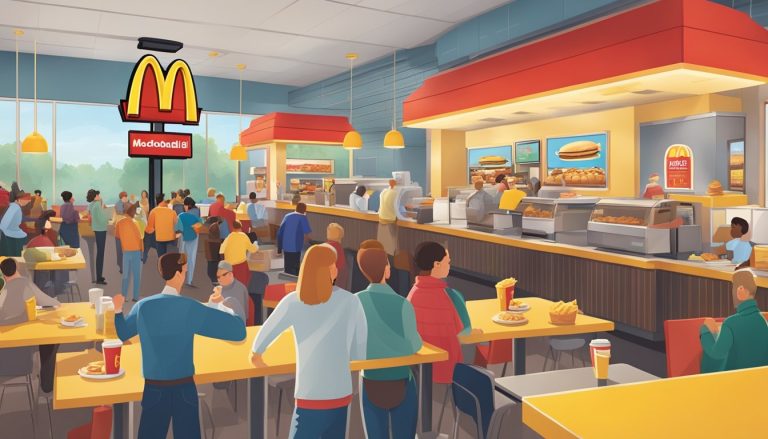McDonald’s introduced all-day breakfast in October 2015, revolutionizing the fast-food industry and challenging traditional mealtime norms. This bold move responded to longstanding customer demands and signaled a significant shift in McDonald’s operational strategy. The decision to serve breakfast items throughout the day had far-reaching economic implications for the company and its competitors.
The introduction of all-day breakfast impacted McDonald’s supply chain, operational efficiency, and customer behavior. It required careful planning to ensure ingredient availability and kitchen workflow optimization. The move also influenced consumer spending patterns, potentially increasing average ticket sizes and attracting new customers seeking breakfast options outside traditional morning hours.
However, the COVID-19 pandemic in 2020 led McDonald’s to temporarily suspend all-day breakfast service. This decision aimed to simplify operations during a challenging period and highlighted the delicate balance between meeting customer preferences and maintaining operational efficiency in the fast-food industry.
Evolution of All-Day Breakfast at McDonald’s
McDonald’s transformed fast food culture with its All-Day Breakfast initiative. This revolutionary change responded to customer demands and leveraged social media influence, reshaping the company’s menu strategy.
Historical Perspective
McDonald’s introduced All-Day Breakfast in October 2015, breaking away from traditional mealtime norms. Before this, breakfast items were only available during morning hours. The decision came after years of customer requests and careful consideration of operational challenges.
The launch proved immensely successful. McDonald’s experienced over 5% sales growth in Q4 2015, marking its strongest quarter in years. This move not only satisfied long-standing customer desires but also attracted new patrons seeking breakfast options throughout the day.
Initially, the All-Day Breakfast menu was limited to select items and only available in the U.S. market. As popularity grew, McDonald’s expanded the offerings and considered implementing the concept in other countries.
The Impact of Social Media Demand
Social media played a crucial role in the creation and success of McDonald’s All-Day Breakfast. Platforms like Twitter and Facebook became forums for customers to express their desire for extended breakfast hours.
McDonald’s actively monitored these conversations, recognizing the potential market opportunity. The company engaged with users, acknowledging their requests and building anticipation for a possible menu change.
When All-Day Breakfast finally launched, social media exploded with positive reactions. Customers shared their experiences, creating organic marketing buzz. This digital word-of-mouth significantly contributed to the initial success of the initiative.
McDonald’s leveraged this momentum, creating targeted social media campaigns to promote All-Day Breakfast. They encouraged user-generated content and used hashtags to track the conversation, further fueling the popularity of the new menu option.
Consumer Trends and Preferences
McDonald’s all-day breakfast responds to shifting consumer behaviors and meal preferences. The move aligns with modern eating habits and the desire for greater menu flexibility throughout the day.
Breakfast On the Go
Busy lifestyles have increased demand for portable breakfast options. The Egg McMuffin and other handheld items cater to commuters and those rushing to work or school. These grab-and-go choices allow customers to enjoy a quick meal without disrupting their schedules.
McDonald’s breakfast items are designed for easy consumption while driving or walking. The company has optimized packaging to enhance portability and minimize mess.
Convenience is key for many consumers. All-day breakfast availability means customers can satisfy morning food cravings at any time, without being constrained by traditional mealtimes.
Changing Meal Patterns
Traditional three-meals-a-day patterns are evolving. Many people now prefer smaller, more frequent meals throughout the day. This shift benefits McDonald’s all-day breakfast offerings.
Breakfast items like McGriddles and Sausage McMuffins serve as snacks or light meals for those eating outside conventional hours. The protein content in these products appeals to health-conscious consumers looking for satiating options.
Late-night workers and students appreciate access to breakfast foods during unconventional hours. This availability caters to diverse schedules and lifestyle needs.
The blurring of meal boundaries has led to increased acceptance of breakfast foods at non-traditional times. Pancakes for dinner or an Egg McMuffin as an afternoon snack are no longer seen as unusual choices.
Menu Items and Popularity

McDonald’s all-day breakfast menu revolutionized fast food by offering popular morning items throughout the day. This move reshaped customer expectations and impacted the company’s sales and operations.
Top-Performing Breakfast Items
The Egg McMuffin stands as the cornerstone of McDonald’s breakfast menu. This iconic sandwich, featuring an English muffin, Canadian bacon, egg, and cheese, consistently ranks as a top seller. McMuffins in various flavors also perform well, appealing to diverse tastes.
Hash browns are another customer favorite. These crispy potato patties complement sandwiches and often serve as standalone snacks. Hotcakes remain popular, especially among those seeking a sweeter breakfast option.
McDonald’s breakfast menu success lies in its mix of savory and sweet items. This variety caters to different preferences and time-of-day cravings, contributing to the all-day breakfast popularity.
Comparative Analysis with Competitors
McDonald’s all-day breakfast offering set it apart from many competitors. While Dunkin’ has long offered breakfast items throughout the day, their menu focuses more on baked goods and coffee.
Starbucks, another major player in the breakfast market, emphasizes premium coffee and upscale breakfast sandwiches. However, they lack the extensive hot breakfast menu that McDonald’s provides.
McDonald’s advantage lies in its ability to offer a full range of hot breakfast items, including eggs and meat, at any time. This flexibility allows them to capture customers seeking heartier breakfast options outside traditional morning hours.
The company’s established brand and widespread presence also give it an edge in the all-day breakfast market. This unique positioning helps McDonald’s maintain its competitive advantage in the fast-food industry.
Operational Efficiency and Kitchen Workflow

Implementing all-day breakfast at McDonald’s required significant changes to kitchen operations and order processing. These adjustments aimed to maintain efficiency while expanding menu offerings throughout the day.
Adapting Kitchen Operations
McDonald’s redesigned its kitchen layout to accommodate breakfast items alongside regular menu offerings. Dedicated preparation areas were created for eggs and other breakfast foods. New equipment like egg cookers and toasters were added to handle increased demand.
Staff training was crucial to ensure smooth operations. Employees learned to prepare both breakfast and lunch items simultaneously. This multi-tasking approach helped maintain service speed during peak hours.
Inventory management became more complex with the introduction of all-day breakfast. Restaurants had to stock sufficient breakfast ingredients throughout the day without compromising freshness or increasing waste.
Improving Order Accuracy
McDonald’s implemented digital menu boards to clearly display all-day breakfast options. This visual aid helped customers understand available choices and reduced order confusion.
New point-of-sale systems were introduced to streamline order taking. These systems included prompts for customization options, reducing errors in complex breakfast orders.
Kitchen display systems were upgraded to prioritize orders effectively. This ensured that breakfast items were prepared alongside regular menu items without delays.
Staff received additional training on order assembly for mixed breakfast and lunch items. This focus on accuracy helped maintain customer satisfaction and reduced food waste from incorrect orders.
Financial Implications and Business Impact
McDonald’s All-Day Breakfast initiative significantly impacted the company’s financial performance and operations. This move reshaped the fast food landscape and influenced both corporate earnings and franchise dynamics.
Sales and Earnings Analysis
McDonald’s All-Day Breakfast rollout in October 2015 quickly boosted the company’s financial results. In the first quarter of 2016, McDonald’s reported higher-than-expected earnings, largely attributed to breakfast item popularity. U.S. same-store sales grew by 5.7%, outperforming competitors in the fast food sandwich segment by 2.9 percentage points.
The extended breakfast menu became a major revenue driver. Reports suggested it could increase sales by 2.5% annually and boost guest counts. This growth was particularly notable given the competitive nature of the fast food industry.
McDonald’s strategic decision to offer breakfast items throughout the day addressed long-standing customer demands. Over 120,000 tweets in the year prior to launch had requested this change, indicating strong market potential.
Effect on Franchises
The All-Day Breakfast initiative had mixed effects on McDonald’s franchises. On one hand, it drove increased customer traffic and sales, benefiting franchise owners’ bottom lines. The expanded menu options attracted new customers and encouraged more frequent visits from existing patrons.
However, implementing All-Day Breakfast presented operational challenges for some franchises. Kitchen reconfigurations were often necessary to accommodate the preparation of both breakfast and regular menu items simultaneously. This required additional investment in equipment and staff training.
Franchisees also faced potential increases in labor costs due to the complexity of managing an expanded menu throughout the day. Despite these challenges, many franchises reported positive outcomes as the popularity of breakfast items helped offset implementation costs over time.
Marketing and Promotion Strategies

McDonald’s employs diverse marketing tactics to promote its all-day breakfast offerings. These strategies leverage both digital platforms and location-specific approaches to maximize reach and engagement.
Leveraging Social Media
McDonald’s utilizes major social media platforms to boost awareness of its all-day breakfast menu. On Facebook, the company shares appetizing photos of breakfast items and encourages user-generated content. Twitter serves as a real-time engagement tool, with McDonald’s responding to customer queries and comments about breakfast availability.
TikTok has become a key platform for reaching younger audiences. The company creates trendy, short-form videos showcasing breakfast menu items and collaborates with popular TikTok creators to amplify its message. These social media efforts help maintain buzz around the all-day breakfast concept and drive foot traffic to restaurants.
Location-Based Marketing Approaches
McDonald’s implements targeted marketing strategies based on local preferences and demographics. The company uses mobile apps and GPS technology to send personalized breakfast promotions to customers near their restaurants. Digital billboards in high-traffic areas display breakfast menu items during off-peak hours to remind passersby of the all-day availability.
In-store promotions, such as table tents and menu board highlights, keep the all-day breakfast option visible to customers throughout the day. McDonald’s also partners with local businesses and events to distribute breakfast vouchers, increasing community engagement and driving sales of morning menu items at unconventional times.
Future Prospects and Expansion

McDonald’s all-day breakfast initiative has reshaped fast-food dining habits and opened new revenue streams. Its future trajectory hinges on market expansion and strategic decisions to maintain customer satisfaction.
Potential Market Growth
McDonald’s all-day breakfast has untapped potential in international markets. Countries with diverse breakfast cultures offer opportunities for customized menus. In Asia, introducing local breakfast items alongside traditional offerings could boost appeal. Europe presents a chance to blend continental breakfast traditions with McDonald’s classics.
Suburban and rural areas in existing markets may see increased all-day breakfast locations. This expansion could target commuters and shift workers seeking breakfast options outside traditional hours. Partnering with food delivery services could further extend reach, especially in densely populated urban centers.
Long-term Strategic Decisions
McDonald’s faces key decisions to sustain all-day breakfast success. Menu optimization is crucial, balancing popular items with operational efficiency. Introducing seasonal breakfast specials could maintain customer interest and drive repeat visits.
Investment in kitchen technology may be necessary to handle increased breakfast demand without compromising other menu sections. This could include dedicated equipment for eggs and griddle items.
McDonald’s must also consider the long-term impact on brand identity. Emphasizing breakfast could shift perception from a burger chain to an all-day dining destination. This repositioning requires careful marketing and consistent quality across all menus to maintain customer trust and satisfaction.




